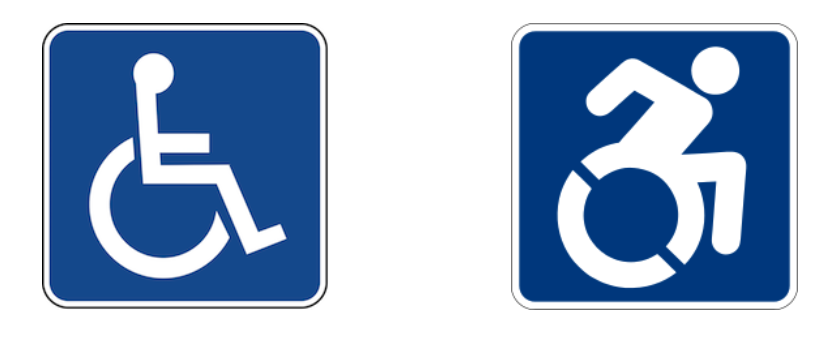
Do you ever stop to think about how your house was built or looked around your town or city to notice the architecture of public spaces? Architecture is about so much more than just shelter. For people with a disability or those dealing with the effects of chronic pain, architecture and design can actually be critical in making life more comfortable and reducing pain. Likewise, wheelchairs have been around for centuries, although the wheelchairs used today are most closely related to chairs designed in the 1930s. Meanwhile, the well-known image of a stick-figure in a wheelchair, called the International Symbol of Accessibility (ISA), has been in use since 1968. How can we redesign a future that inspires more accessibility for all people? We’ve got some ideas.
Towards a wheelchair redesign
No significant wheelchair redesign has taken place in the last several decades. The modern wheelchair has served its basic purposes well, but recently many people have been clamoring for a redesign.
Certainly today’s wheelchairs are preferable to those of the early 1900s, since they’re made of better materials. However, when it comes to the most basic elements of a wheelchair – such as the chair itself – few design improvements have occurred. Sitting in any position for an extended period can be extremely uncomfortable, and a wheelchair is no exception. Slowly, though, more options are becoming available.
Tilt-in-space wheelchairs
For self-propelled wheelchairs, a tilt-in-space wheelchair may be a good option. These wheelchairs allow their users to tilt the seat of the chair and redistribute body weight. However, these chairs can be heavy or cumbersome, and they’re often extremely expensive. Many self-propelled wheelchair users have to make do with regular position changes, seat cushions, and ergonomic inserts.
For motorized wheelchairs, engineers are developing a unique solution to this type of discomfort, as explained in an article from Empa:
“The new seat shell has an articulated backrest constructed of ribs and movable joints which are designed to match the contours of the user’s torso. Depending on the version, the backrest can be tilted up to 22° forwards and 40° backwards and seat can also be rotated by a good 30° in each direction horizontally. The wheelchair user is therefore strongly encouraged to keep changing his or her position, thereby shifting the location of the pressure points.”
The seat shell runs from the same battery as the wheelchair. Also, the settings are all customizable. An ergotherapist can adjust the seat for optimum positioning, but if the user is uncomfortable, he or she can make further adjustments at will.
Propelling redesign
People who utilize self-propelled wheelchairs face a unique problem. When using a self-propelled or manual wheelchair, a person must grasp the rim on the back wheels and push. This motion utilizes small muscles in the shoulders and, over time, can lead to repetitive stress injuries. NASA engineer Salim Nasser has come up with a wheelchair redesign that combats this issue. He has designed new wheels that use a planetary gear, so that users pull instead of pushing. The resultant motion is similar to rowing.
In addition to being a more efficient use of energy, this could offer some significant health benefits to manual wheelchair users. Jackie Justus, a spinal cord nursing educator, expands on these benefits in an article published in Popular Science:
“Pulling, she says, uses larger stronger muscle groups, while pushing a wheelchair uses little muscles in the front of the body and also hunches over the upper body. The rowing motion makes wheelchair users sit up straight, she says, allowing the diaphragm to function properly and significantly improve breathing.”
Even more exciting, a group of high school students designed a similar wheel for a class project. Their final product allows the wheelchair user to alternate between pushing and pulling. Better yet, a 3D printer creates almost all of the parts for two to three dollars per part.
Better wheelchair accessories
People asking for wheelchair redesign also want a larger variety of practical, visually-appealing accessories.
The majority of the wheelchair accessories available now are highly practical, but they’re very lacking in fashion or aesthetics. Most items are available only in black. This may not seem like a big deal, but consider everything that we use on a daily basis. Phones, phone cases, computers, furniture, cars, clothes – everything else in our day-to-day lives seems to be customizable, but people who use wheelchairs only have plain, basic accessories.
At Brunel University London, students have developed a list of items that should be more fashion-savvy and customizable for wheelchair users. Items on the list include:
- A practical, attractive bag
- A cup-holder that can hold drinks other than standard water bottles (like a cocktail glass)
- Chairs in colors other than black
- Fashionable waterproof covers
Sites like PimpMyChair.com and GettingBackUp.org compile different online resources where wheelchair users can find unique accessories, such as lighted casters and hands-free umbrellas. The website Etsy also has several virtual shops with wheelchair accessories, like wheel covers and even wheelchair costumes for kids.
A redesign of the ISA
Each wheelchair user is unique, so more customizable chairs and accessories will allow each individual to express himself or herself more fully. The symbol associated with disabled people, the ISA, doesn’t adequately reflect the individuality of wheelchair users; this is largely why many people wanted to redesign the ISA. Slowly, we’re starting to see the more dynamic ISA symbol across parking spaces and in office buildings.
The traditional ISA – the symbol that adorns parking spots, automatic door buttons, and many other places – was a big step forward when it was first introduced, as noted in a Huffington Post article:
“When it was first introduced, it was hoped that the public would be encouraged by the wheelchair symbol to become more aware of the circumstances of people with disabilities. For those living with disability, it was to be a sign of freedom, the marker that meant buildings were accessible and parking spots available.”
Indeed, the ISA wheelchair symbol did its job, aided by the passing of the Americans with Disabilities Act in 1990. Since then, though, critics have noted that the ISA isn’t very representative of people in wheelchairs. The stick figure is static and unmoving.
Modified ISA symbol
Instead, a revised symbol was introduced. The modified ISA symbol is still a stick figure, but instead of sitting passively, the figure leans forward, its arms on the wheels to propel itself forward. Originally meant to be layered over top of existing ISA symbols, it’s gained such popularity that several states are replacing older symbols with the new, more dynamic one. Likely, you’ve started seeing this symbol more often.
However, since a relatively small portion of disabled people actually use wheelchairs, others have taken the debate a step farther. They’ve suggested a new ISA symbol that doesn’t feature a wheelchair at all. So far, there’s been little talk of actively replacing the current accessibility symbol with one devoid of a wheelchair. However, it’s certainly an interesting aspect to the conversation.

How can we create more accessible buildings?
Did you know that efforts to make buildings more accessible to people with disabilities was actually brought about by the Civil Rights Movement starting in the 1960s? In 1968, Congress passed the Architectural Barriers Act (ABA) that was designed to ensure that all people had access to buildings in their communities. This Act was also passed prior to the Americans with Disabilities Act that helps disabled workers on the job.
This is why public buildings have ramps for wheelchairs and bathrooms that are accessible by everyone.
Adding accessibility to your home
While having accessible spaces in public is important, what about the ways you can make your own home more comfortable? Not everyone is going to need wheelchair accessibility, but these modification can help many with different types of disability.
Here are a few ways you can modify your current home or build a future home to suit your needs.
- Eliminate or reduce stairs: Single story living is often the best thing for someone with chronic pain, especially in the hip or the knees. Keep this in mind not only for the inside of your home but also the front porch or in the garage.
- Automate the home: Today, architecture, design, and technology all meet to give homeowners a better user experience overall. You can use motion sensors for lights. A mobile app can control many of the functions that will help you stay comfortable. Automatic door openers, key pad locks, and intercom systems are all good solutions for a more accessible home.
- Ensure the bathroom is accessible: So many accidents in the home happen in the bathroom. Slippery tile and water can lead to falls and worse. Consider an accessible shower or wet room design. You may also want to install a walk in bathtub. Use benches in the shower so you can sit if standing becomes a problem. A raised toilet will also help someone with hip or knee pain.
- Use lots of windows: Natural light is one of the best things to improve your mood and overall mental wellbeing. Natural light is easier on the eyes as well. You can add skylights, French doors, and plenty of windows to improve the lighting in your house.
- Railings and handles: To prevent falls around the house consider installing railings, balance bars, and handles in strategic places where you might need a little extra help. These can be designed decoratively so you don’t feel constantly reminded about their purpose.
- Lower the kitchen workspaces: Standing at the kitchen counter to prepare food can be a problem. Create a space in your kitchen where the counter is lower. There, you can sit to chop vegetables and mix up a batch of cookies. This will also allow you to use the kitchen in the future if you are in need of a wheelchair in the home.
- Redesign your closet space: If you have joint pain, reaching for hanging clothes or putting away laundry can be a challenge. Make sure your closet is easy to use. Hang clothes lower so you can reach them without stretching. Use bins or drawers that can help you sort and organize your items.

MEDCottages
For some people there may eventually be a need for something more when it comes to accessible architecture and care for chronic pain and illness. MEDCottages are a great solution for short- or long-term care if assisted living or nursing homes are not desirable or a good option. This is a mobile unit that sits on the land of a family member or caretaker. It has the most up-to-date technology for comfortable and accessible living.
MEDCottages can provide comfort and a pleasant environment for someone dealing with medical challenges. There are three models ranging from around 290 square feet to just over 600 square feet. All water and electricity is provided by the host home. There is a small kitchen, accessible bathroom, and bedroom designed for the best possible care.
A MEDCottage is also a smart home that can monitor the resident’s overall health. It can alert caretakers to a potential problem. It can even remind the resident to take their medication on time.
MEDCottages are also affordable when compared with a facility, buying a home, or renting. The largest model costs just over $60,000. The homes are mobile which means you can move them to the best location possible.
What other ways do you think we should rethink disability and inclusion and accessibility in the coming years?